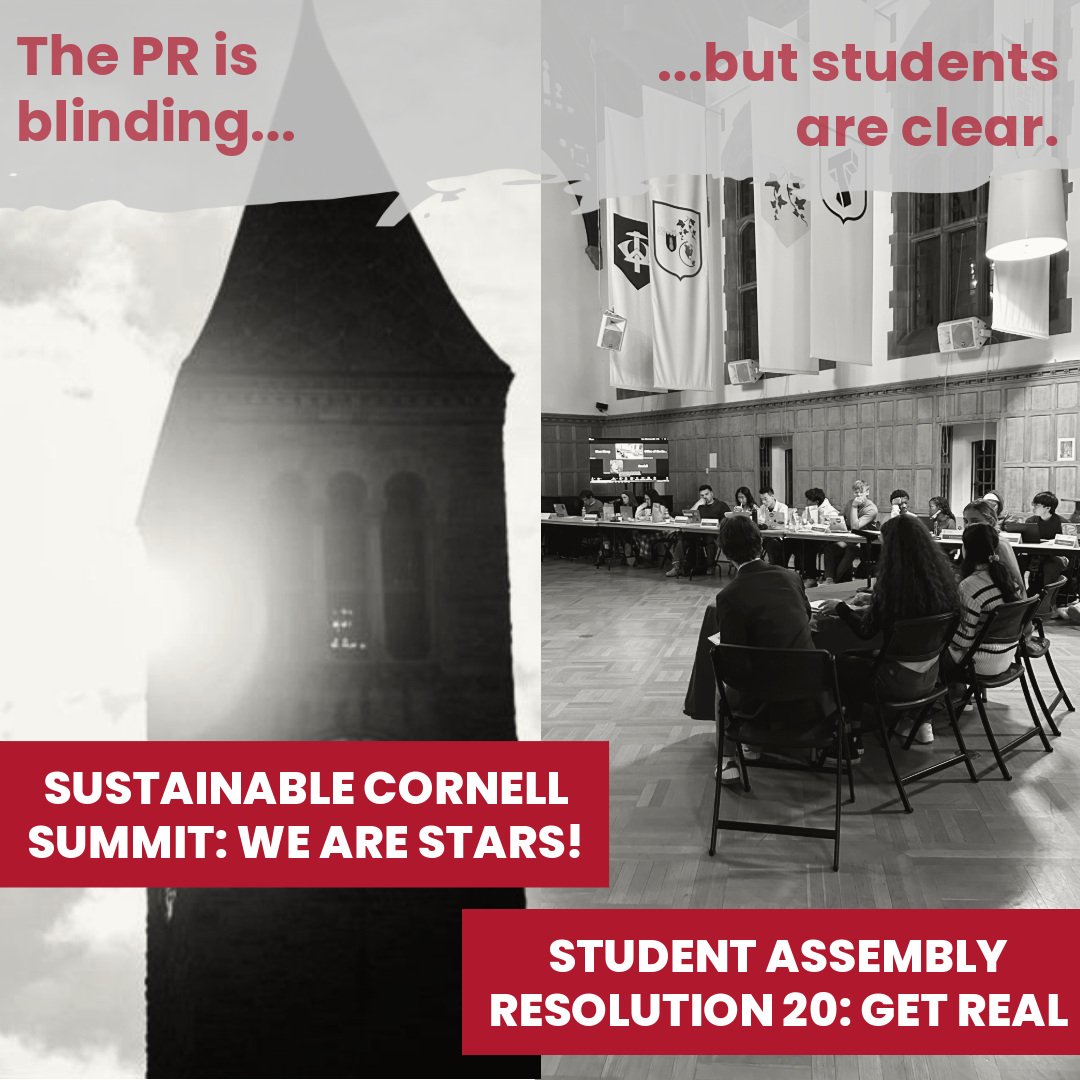Newsletter #12: Good Tidings of Decarbonization
a tale of two cornells
Dear Cornell on Fire,
Two of Cornell’s governing bodies weighed in on Cornell’s State of Sustainability this month, and their conclusions could not have been more divergent. As the administration doubled down on their well-intentioned incrementalism, the Student Assembly had enough: they advanced a resolution to dramatically expand and accelerate Cornell’s Climate Action Plan. In another case of idealists versus hard-nosed realists, we bring good tidings: the students (the realists) are right, and a new white paper on Cornell’s Heating Decarbonization pathways underscores the strength of their case.
The sun is always shining when Cornell’s administrators take the stage to expound on progress toward “carbon neutrality” (a problematic concept, much-liked by greenwashers). On December 9, administrators led by Rick Burgess, Vice President of Facilities and Campus Services, delivered yet another bubbly State of Sustainability Address. The Cornell they spoke of boasts year-on-year platinum STARS ratings and progresses splendidly towards carbon neutrality, at least as depicted in a “beautiful graphic” without numbers.* As for the numbers: it was actually suggested (without a trace of irony) that it might be “reductionist” to focus on reducing Cornell’s own carbon footprint.
The students see through this. On December 5, the Student Assembly adopted a resolution to renew Cornell’s Climate Vows (inspired by our demands). The Cornell they speak of is considerably less starry than that of the administrators: the university systematically underreports its emissions, excludes the vast majority of its carbon footprint from its climate action plan, and is not progressing as promised. The resolution lays out forward-looking proposals for improvement including (1) adopt sustainability as a core institutional goal (translation: put your money where your mouth is); and (2) decarbonize now.
As winter arrives in Ithaca, all our heaters are hard at work, bringing one of the key disagreements into stark relief: When should Cornell start decarbonizing its campus heating systems? Cornell’s flagship heating decarbonization project, Earth Source Heat, remains experimental. If successful, it will only (optimistically) serve the campus by 2035. What should Cornell do in the interim?
This question is as weighty as the manifold new construction projects on campus. Look around at the sprawling chaos of new buildings rewriting the ecosystem on The Hill.* Not only does each building grind its concrete foot into the face of Cornell’s 2013 climate pledge to reduce new construction (such a quaint notion!)* – but it adds insult to injury by using fracked gas from Cornell’s Combined Heat and Power Plant for heating, rather than decarbonizing each building by installing heat pumps.
The Student Assembly resolution calls for immediate decarbonization of all new construction. So does the Ithaca Energy Code Supplement (IECS). Informally known as Ithaca’s “Green Building Code,” the IECS mandates fossil-fuel phaseout in all new construction and major renovations. You would think that Cornell, self-proclaimed climate leader, would embrace this law wholeheartedly. Quite the opposite. Cornell has submitted amendments to make themselves exempt from Ithaca’s fossil-fuel phaseout. Their argument? When not presenting Earth Source Heat as the solution (never mind its delay), they claim that their hands are tied, because regrettable features of the NY electricity grid mean that decarbonization at Cornell would backfire by increasing grid emissions elsewhere. For years, Cornell’s scientists and local environmentalists have argued that they are wrong, and that Cornell’s delayed decarbonization strategy carries tremendous emissions costs.*
The answer can only be found by modeling the emissions associated with each decarbonization pathway. (Cornell’s administrators have provided no such modeling to support their claims.)
Fortunately, Cornell engineers and a University of Illinois statistician have just delivered a gift to Cornell’s decision makers: a white paper that models the emissions associated with Cornell’s two possible decarbonization pathways (immediate vs. delayed). They find that immediate decarbonization does save carbon emissions – significantly – in all cases tested and under all NY grid projections.
The white paper makes three contributions to Cornell’s – and Ithaca’s – decarbonization pathways:
It supports a key ask of the Student Assembly Resolution and Cornell on Fire Demands.
It supports the integrity of Ithaca’s Green Building Code as currently written.
It reveals that Cornell’s delayed decarbonization is costly for people and planet, and may cost Cornell and Ithaca its climate goals.
Cornell’s decision makers need to take full accountability for the steep climate and social costs of their business-as-usual approach to heating new construction with fossil fuels.*
Strike another victory for the students, who have once again outpaced Cornell’s administrators in Reality 101. As one Student Assembly member noted (paraphrasing), “this will be the most important piece of legislation we’ve passed all year.” Their tale is the one that Cornell needs to hear: the climate emergency is real, immediate decarbonization is required, and a qualitative break from administrators’ business-as-usual attitude is imperative.
Happy winter,
Cornell on Fire
*Asterisks indicate supplemental notes: the curious reader may scroll to the bottom of this page to consult those notes.
Support the Student Assembly Vote on the Resolution to improve Cornell's Climate Action Plan:
Join us at the Assembly meeting on January 23, 2025 (4:45-6:00 pm), Willard Straight Hall Memorial Room (407). All members of the Cornell community and public can join to watch the meeting and/or give public comments in support of the resolution. The Cornell on Fire: Eco Justice Solidarity Program has created an optional RSVP form with useful information here!
Are you a faculty or staff member interested in introducing a similar resolution to your respective Senate/Assembly at Cornell? Please email us at connect@cornellonfire.org.
Time is precious. End-of-year Donation Call:
The most effective gift you can give our movement is your acuity, moral outrage, and willingness to act. These gifts are especially effective when they manifest in the dimension of time. Please click here to donate minutes or hours of your time to our movement. Don’t miss this gratifying list of options for time-spending!
Learn more about the real state of university sustainability:
At Cornell:
Read our reports on the state of climate action at Cornell. What you need to know to demand the change we need.
Read the new student analysis of climate-related courses in Freshman Writing Seminars. It reveals incremental progress, with much work to be done.
Beyond Cornell, there is increasing awareness that sustainability needs to reach a new state:
Check out the launch celebration and discussion of the new book Climate Justice and the University by Jennie C. Stephens, Professor of Climate Justice, National University of Ireland Maynooth. Building on the sobering acknowledgement that “universities are not yet structured to accelerate social change for the public good,” the book outlines how they might do so.
Bryan Alexander’s book Universities on Fire: Higher Education in the Climate Crisis won the prestigious Frederic W. Ness Book Award from the American Association of Colleges and Universities. An encouraging sign that at least some higher education officials are breaking from rose-colored assessments of university “sustainability” and updating their worldview to accommodate our climate-disrupted reality. (Our movement name draws its inspiration from Bryan’s book and we’re honored that he serves as one of our movement advisors.)
Engage the Wider Movement:
Join concerned citizens and scientists in opposing Cornell’s newest proposal for yet more artificial turf fields. Their latest proposal is currently under review by the Ithaca Town Planning Board despite an ongoing lawsuit. We need to submit a strong set of written public comments to the Planning Board in advance of their next meetings on January 7. Write to Zero Waste Ithaca (info@zerowasteithaca.org ) or Cornell on Fire (connect@cornellonfire.org) to get involved with next steps.
Extinction Rebellion Climate Vigils 11am every Saturday at Chase Bank - the worst bank on Earth - at the East end of the Ithaca Commons.
Earth to Biden: Declare a Climate Emergency. Scientist Rebellion Turtle Island is about to close their petition to President Biden pressuring him to declare a climate emergency before he leaves office. Please sign it and share it with friends, family, everyone you know, before the end of the year!
In case you missed it … catch up on our latest work:
Check out our latest communications:
Cornell on Fire Post 12/6: AD White weighs in on the expressive policy
Position Statement: Don’t Muzzle Us (response to the draft Expressive Activity Policy)
Check out our latest actions:
As always: Thank you for reading this far and engaging in the number-one frontline for climate action: your attention.
Supplemental notes for the curious reader:
STARS is an acronym for the Sustainability Tracking Assessment & Rating System run by the American Association of Sustainability in Higher Education (AASHE). This rating system has been critiqued for its misleading and ineffective rating metrics that dramatically downplay the variable that matters most for climate (greenhouse gas emissions). We have re-analyzed Cornell’s own self-reported STARS performance in our Cornell Climate Curriculum Report and Climate Action Plan Report.
Cornell’s construction spree: An incomplete list of current and planned construction at Cornell: Atkinson Hall (104,000 square feet), Bowers College of Computing (135,000 SF), Meinig Fieldhouse (91,150 SF), Thurston/Tang Hall addition (50,550 SF), Duffield Hall expansion (46,000 SF), and others.
Cornell’s failed pledge to reduce campus expansion: In 2009, Cornell’s original Climate Action Plan noted that, “While the most sustainable structure is the one that is never built, physical growth is necessary to support the university’s mission.” The 2013 Climate Action Plan Update and Roadmap stated that “This sobering statement from the 2009 CAP is still true today” (p. 43). Although they wouldn’t let sustainability stop them from expanding, the 2013 Roadmap at least pledged to “cut campus space projections in half compared to our 2009 projections – from 4M to 2M square feet of new space” [this figure apparently includes all new construction through 2040]. That pledge has proven empty. Cornell has already added nearly 2 million square feet of building space: current construction projects alone total nearly half a million square feet, on top of the 1.2 million square feet that have already been added since 2013. (In their 2013 STARS report, Cornell reported the gross total of campus facilities at 15.4 million SF. By 2023, that number had grown to 16.6 million SF [an additional 1.2 million]). Adding current construction projects at Cornell brings the total of new construction to nearly 1.7 million SF - meaning that once the current building spree ends, no new construction can occur until 2040 if Cornell is to make good on their pledge. The decarbonization debate was especially heated (no pun intended) during the North Campus Residential Expansion, the largest construction project in Cornell history (760,000 SF). Cornell moved ahead by heating that building with fracked gas rather than decarbonizing its heating systems. Thus, this particular debate has been active since at least 2019, when experts and environmentalists alike argued that Cornell would reduce carbon emissions by installing ground-source heat pumps in the new dorms. Cornell and the ever-deferential City of Ithaca Planning Board ignored these arguments and approved the project without a positive declaration of environmental significance.
Cornell argues that their hands are tied. Vice President of Facilities Rick Burgess’ claim at the December 9 State of Sustainability Address was only the latest instance of this hand-wringing. Cornell’s energy team has also made this argument, including at a Tompkins County Climate Protection Initiative presentation in June 2024, and it underlies their proposed amendments to the IECS.
The social cost of Cornell’s delay. In case carbon emissions aren’t earth-destroying enough, Cornell’s delayed decarbonization is also very socially costly. A PNAS paper just updated the social cost of carbon emissions significantly upwards to $280 per ton. In their 2016 Analysis of Solutions, Cornell’s climate leadership team recommended using a social cost of carbon in all university decision making. There is no evidence that they have done so, but if Cornell were to follow their own recommendations, this white paper shows that their current delayed decarbonization approach is costing society dearly.
Newsletter #12 originally published on December 30, 2024.


